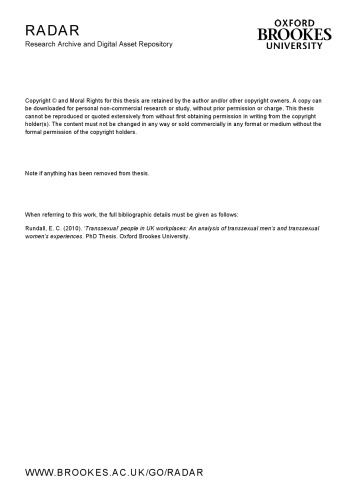Product desciption
Transsexual People In Uk Workplaces An Analysis Of Transsexual Mens And Transexual Womens Experiences Emma C Rundall by Emma C. Rundall instant download after payment.
This thesis explores transsexual men’s and transsexual women’s experiences of UK workplaces. It investigates the mediation of visible/invisible gender-diversity/atypical gender-history, and the ways in which this influences trans-employees’ experiences of discrimination, protection, support, and inclusion/exclusion. Gender is discussed in terms of individual/interpersonal everyday experiences, and as macro societal institution/organizational regime dependent on the repetition of societally recognizable gendered signifiers and ‘expected’ practices. The study then goes on to examine business approaches to trans-employment equality, and responses to transfocussed/inclusive equality legislation. Poststructuralist and queer theory perspectives provided the theoretical framework for this research in order to interrogate and illuminate the research findings. The research focuses primarily on the self-reported experiences of individuals who identify as the sex-category opposite to the one ascribed at birth, regardless of their transition or employment status at the time of participation. This inclusion criteria was chosen because these individuals are the only gender-diverse sub-group to legally be afforded protection and potential gender-recognition. 106 trans-participants were recruited via a combination of snowball and convenience sampling to maximise the diversity of the sample. Quantitative and qualitative data was then collected via an anonymous asynchronous websurvey, which allowed participants to remain entirely anonymous, and participate at a time safe and convenient for them. Semi-structured interviews were also conducted with eight business representatives selected from lists of organizations reported to have a strong focus on equality and diversity. Businesses were contacted by email and telephone, and informants interviewed face-to-face or via telephone. All of the interviewees were de-identified from their responses to prevent legal and personal repercussions, and to avoid deterring participation. Notions of (in)visibility, visibility, and invisibility, are employed as conceptual tools through which to explore the extent to which one’s gender-diversity, including history, is visible or invisible to the present or absent onlooker (see also Rundall and Vecchietti 2010). (In)visible gender-diversity greatly impacts upon trans-employees’ workplace experiences, and the extent to which their ‘transness’ is perceived to be ‘palatable’ by cisgender onlookers, subsequently influencing the degree to which the trans-individual is othered. ‘Visibly’/‘knowably’ gender-diverse individuals face a significant threat of transphobic discrimination and ostracism, although some do successfully gain acceptance of their gender-identities, and receive support and inclusion. Significant variation was found between the experiences of trans men and trans women, and participants employed in different sectors. Legislation was shown to have impacted upon organizational approaches to trans-equality, particularly in relation to policy-provision. And yet, trans-equality continues to be viewed and constructed as subordinate to other more ‘dominant’/societally ‘valid’ equality-strands, and so is frequently denied investment. Thus, many businesses lack the knowledge and mechanisms needed to implement legislation and policies into day-to-day practices, which perpetuates trans as sous rature (under erasure). Through its focus, this thesis makes a contribution to both theoretical and practical knowledge surrounding: the doings/undoings of gender; identity constructions and related interpersonal and intertextual interactions; and the impact of medical, legal, and other dominant societal frameworks; in the UK employment sphere.


